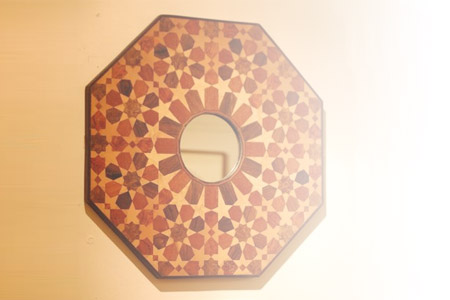The Tree of Life and the Eternal Garden
Issue 94 July 2012
EXHIBITION
The Tree of Life and the Eternal Garden
Review by Medina Whiteman
‘An interfaith art exhibition inspired by the Christian and Islamic traditions’
In every place and time, throughout human history, we have gravitated towards trees for shelter, food, firewood – and, sometimes, just to lie beneath its shimmering green canopy and let the worries of the world drift away. In the solidity and strength of a great oak or chestnut, we find reassurance amid the maelstrom of life.
In the Muslim and Christian traditions, trees carry huge significance, both worldy and spiritual. The Prophet Muhammad (s.) said: “If a Muslim plants a tree or sows seeds, and then a bird, or a person or an animal eats from it, it will always be regarded as a gift for him.”*
“Both traditions tell of a central tree, that shelters and supports all life, bridging earth and the heavens. Each and every one of us is borne by the One Tree and find our place amongst its branches,” explains Diane George, one of the artists contributing to the Tree of Life exhibition at St. Barnabas Church in Walthamstow.
Floral and foliate designs are a common feature of both Christian and Muslim art, and it is interesting to note in the exhibition literature that both Qur’anic and Biblical references are cited denouncing ‘graven images’. Instead, these artworks, whether Christian or Muslim in origin, portray stylised shapes drawn from nature: flowers, swirling pools of blue and gold, dancing paper leaves, geometric constellations and the symbolic image of the tree itself.
From the rich, organic colours of Amber Khokhar’s exquisite Islimi watercolours and ceramics, to the cosmic intertwining designs of Diane George’s mandala-like paintings – one of which is even backlit – it is clear that there is an intermediate space in which Christian art can reflect the mind-blowing abstraction typical of Islamic art, which in turn can also portray the realistic beauty of nature so beloved of Christian artists.
Tom Bree’s intricate stellar geometric marquetry takes us into the realms of symbolism. His piece ‘Circumnambulation’ could just as easily depict the movement of neutrons around an atom, or planets around a Sun. This is art that is not only visually harmonious, but that moves us to think, feel, contemplate the natural world that we inhabit and to change our perspective from microscopic to universal.
Geometric forms call upon the shared experience of the natural world that all people have, regardless of their religion. Though Christian and Muslim art forms evolved in largely separate cultural spheres, both were based on the same visual mathematical grids that anyone can draw with a compass and a piece of paper.
Repetition is also a common feature. In the vegetative designs of Islamic art, known as islimi, the base structure for a design is a swirling stem, which could go on infinitely. From this sprout foliate and floriate shapes (the most basic of which, called the Rumi, was borrowed by William Morris to create the paisley), cross-sectioned flowers (hataei), buds, palmettes and lotuses. The cyclical, repetitive, symmetrical patterns call to mind the cycles of life in plants, animals and man, and are designed to be an aid to contemplation of their Source.
Beyond symbols, though, there is a depth to this kind of art, as we see in Lisa de Long’s incredibly rich, layered, egg tempera paintings – many of which feature trees, not just as meaningful icons, but as a vision of a garden that never ends. This is a perspective borne of respect and love for the sacred, of the artist viewing his or her art as a kind of prayer.
The inspiration for this exhibition is Tree of Life, a universal motif that draws us back to the prophetic origins of the monotheistic faiths, through Abraham back to Adam. It also suggests the variety of expressions that this core principle can take. As Julian Bond, the director of the Christian-Muslim Forum which commissioned these works of art, remarks, “building friendships and learning about each other are works of art too”.
It is no coincidence that the vision of a tree bursting forth in blossom and fruit is one that all civilisations treasure. The garden is the image of Paradise par excellence:
“Truly those who are conscious of God will be in gardens and among springs.
Enter! (They will be) at peace, and safe. We will remove from them any hatred from their breasts, and they will be as brothers, reclining on couches, face to face with one another.”
(Qur’ân, Al-Hijr, 45-47)
It is impossible not to notice the call to peaceful dialogue in this depiction of Paradise. At a time when Muslims are painfully depicted in so many news sources as ‘problems’ in the pluralism equation, it is heartening to see a show of solidarity that is not only a feast for the eyes, but also a balm for the soul. As the 13th century Persian mystic al-Bistami said: “Like a compass, we have one foot secure in Islam, and with the other we traverse the world’s religions.”
* Narrated by Anas b. Malik, Sahih Bukhari
http://christianmuslimforum.org
4 April – mid-July



Comments
0 Comments